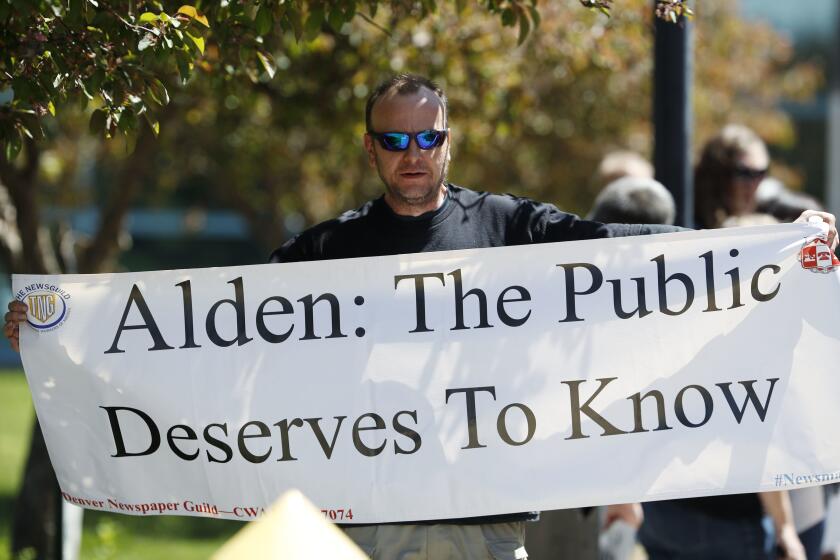‘Dorothea Lange’ by Linda Gordon
Dorothea Lange
A Life Beyond Limits
Linda Gordon
W.W. Norton: 536 pp., $35
Our image of the Great Depression has been indelibly shaped by the photographs of Dorothea Lange: homeless men standing dejectedly in line for food at a San Francisco mission, rickety jalopies crammed with the household belongings of farmers fleeing the Dust Bowl and, most famous of all, “Migrant Mother,” Lange’s majestic, sorrowful portrait of a destitute pea picker, baby at her breast, two older children leaning on her shoulders as she gazes stoically into the distance. Stark but not sordid, compassionate but not mawkish, these photos made palpable the human cost of the economic crisis and implicitly argued that the American people deserved better. They incarnated the convictions and commitment of the activists who staffed President Franklin Roosevelt’s New Deal programs; Lange was one of them, taking her most memorable pictures as a government employee charged with publicizing the work of the Farm Security Administration.
She was “a photographer of democracy, and for democracy,” writes historian Linda Gordon, whose thorough biography “Dorothea Lange: A Life Beyond Limits” is at its best when detailing Lange’s working methods and the distinctive qualities of the images those methods produced. The author also vividly conveys Lange’s complicated, volatile personality and the way it was expressed in her clothing, her homes, her cooking, even holiday gatherings for her large, blended family. These considerable merits almost compensate for Gordon’s irritating tendency to view Lange through a politically correct lens.
She was born Dorothea Nutzhorn in 1895, the daughter of prosperous, educated German Americans living in New Jersey. At age 7, she contracted polio, which left her with a weak, deformed right leg and a fierce determination never to be dependent. Five years later, her parents separated; she never forgave her father and in 1918 took her mother’s maiden name, remaining Dorothea Lange for the rest of her life.
Enrolled in school in Manhattan, she cut classes to roam the streets. She “learned to see on those walks,” she later said, and upon graduating from high school, astonished her mother by announcing that she wanted to be a photographer. Dorothea had never even held a camera, but that didn’t stop this assertive young woman from getting a job with Arnold Genthe, the premier portrait photographer of the day, and then with other commercial photographers. Visiting San Francisco in May 1918, she fell in love with the city and within a few months had opened her own photography studio.
Lange spent the 1920s as a successful portrait photographer. Her warm, dramatic personality won her many friends among the San Francisco business elite, who paid to have her take their pictures, as well as in the bohemian artistic circles where she met her first husband, painter Maynard Dixon. She was the chief breadwinner and primary caretaker of their house, their two sons and Dixon’s troubled daughter from his first marriage; we hardly need her biographer’s explanation that “she had no access to alternative prescriptions for womanhood” to understand the strains this created. It was Lange’s burgeoning social consciousness, and her desire to embrace a different kind of photography, that finally broke up the marriage in 1935.
By then she had met Paul Taylor, a progressive economist who wanted a photographer to accompany him on his field trips researching the plight of farmworkers for the Department of Agriculture. He became Lange’s second husband, and her work with him over the next five years constitutes her defining achievements as an artist -- “a visual sociologist,” as Gordon aptly characterizes her, whose images, though usually centered on individuals, also made palpable the dire circumstances in which they lived and the appalling conditions under which they labored. Her visual compositions anatomized social relations, as in a shot of a Mississippi general store where the physical postures and placement of a white plantation owner and his black sharecroppers reveal an unequal power structure. Lange emulated Taylor’s quiet, unthreatening approach to subjects in the field; she applied the social skills she’d developed as a portrait photographer to the sensitive task of persuading impoverished, apprehensive people to let her take their pictures. She justified their trust with photos that emphasized their dignity and found beauty in careworn faces and gnarled hands.
In later years, Lange’s respectful approach was sometimes seen as sentimental. Gordon convincingly refutes this charge by pointing to the complexity of her images and their firm location in a historical and physical context, buttressed by captions Lange considered essential to understanding the photos. She shared with Taylor a passionate belief that by exposing poverty and injustice she could spur Americans to alleviate them, but Lange was no simple propagandist. A good photograph, she later told her students at the California School of Fine Arts, “raises questions that are not answered.”
She continued to raise uncomfortable questions. Lange’s photos of the internment of Japanese Americans in California were suppressed by the Army, the very entity that hired her to take them. (Gordon edited a volume of these photos in 2006.) Lange attempted to get tougher images into Edward Steichen’s soft-focused “Family of Man” exhibit at the Museum of Modern Art in 1955. Life magazine refused to publish her photo essays documenting the social consequences of the building of a Northern California dam and the work of a public defender in Oakland. Grueling trips in the late ‘50s and early ‘60s with Taylor, now an international consultant on agrarian reform, taxed her fragile health. Her final years were spent at home in Northern California, where she died in 1965.
Given the author’s obvious admiration for her subject, one wishes she had eschewed anachronistic agonizing over such things as “the inequality of the transaction” between the “middle-class urbanite” photographer and her “uneducated, often darker-skinned” subjects, or the hardly astonishing fact that both Lange’s husbands left the housework to her. Applying such contemporary standards detracts from Gordon’s moving, intelligent portrait of an artist who set the standard for every socially concerned photographer who followed by depicting the oppressed not as pathetic victims, but as fellow human beings ensnared in circumstances that could and must be changed.
Smith is the author of “Real Life Drama: The Group Theatre and America, 1931-1940.”
More to Read
The biggest entertainment stories
Get our big stories about Hollywood, film, television, music, arts, culture and more right in your inbox as soon as they publish.
You may occasionally receive promotional content from the Los Angeles Times.










